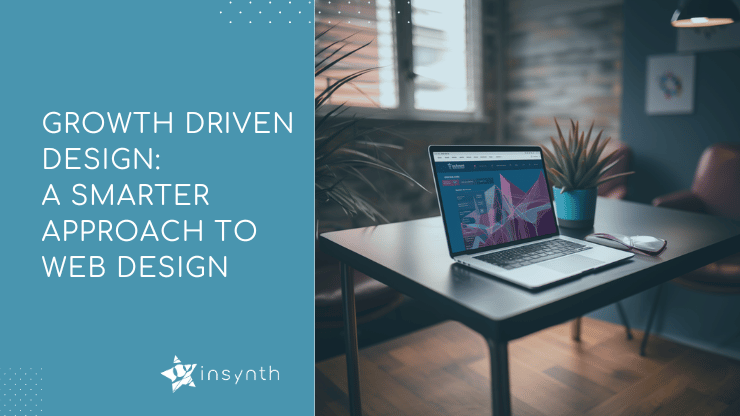3 min read
Growth Driven Design: A Smarter Approach to Web Design
![]() Leigh Simpson
:
07-Sep-2023 12:22:10
Leigh Simpson
:
07-Sep-2023 12:22:10

Growth Driven Design (GDD) is a website design and development approach that emphasises continuous improvement and optimisation that is is particularly effective in the built environment.
Here's how it can help you launch website projects more quickly while improving results.
Unlike traditional web design, which typically involves creating a large, complex website all at once and then making occasional updates and changes, GDD involves building a website in phases, based on data and feedback, and continually refining and improving over time. This can significantly improve outcomes of build product website design projects.
This strategy allows building product companies to quickly launch their website projects, enabling them to gather valuable data that informs optimisation decisions, continuous improvement, and ultimately helps achieve business goals and ROI.
By launching quickly and gathering data, companies can make informed decisions to optimize their websites, leading to improved user experiences, increased conversions, and ultimately, better business outcomes.
With Growth Driven Design, building product companies can stay ahead of the curve, continuously improving their websites to meet the ever-changing demands of their target audience of specifiers, designers, contractors, developers, and clients.
Here's how to take a Growth Driven Design approach on your next project:
1. Launch quickly to get data
Creating an MVP and swiftly launching it provides a unique opportunity to gather essential user data. This data can drive website enhancements:
- User Engagement: Track user interaction through metrics like click-through rates, session duration, and bounce rates.
- User Behavior: Analyze the paths users take on your site to identify bottlenecks and issues.
- Conversion Rates: Measure how effectively your site converts visitors into customers or leads.
- Performance: Monitor page load times and server response for smooth user experiences.
- Feedback: Encourage user comments and suggestions for qualitative insights.
Gathering this data enables data-driven improvements, making your website more user-friendly and effective.

2. Continuous Improvement
Traditional website design often follows a linear process, where a website is meticulously planned, designed, and launched in its final form.
In contrast, a continuous improvement approach based on user data adopts a more iterative and adaptive strategy. Rather than considering the initial launch as the endpoint, this approach views it as the beginning. This helps you avoid major pitfalls of traditional website design.
By constantly gathering and analyzing user data, such as engagement metrics and behavior patterns, website owners can make ongoing adjustments. This allows for the timely identification of issues and opportunities, resulting in a website that evolves to meet user needs and preferences.
It's a dynamic process that ensures the website remains relevant and effective in an ever-changing digital landscape, ultimately leading to higher user satisfaction and improved business outcomes.
3. Business Goals and ROI
Implementing a GDD approach based on user data isn't just about enhancing the user experience; it's a strategic move that directly impacts business goals and return on investment (ROI).
By consistently optimizing a website to align with user preferences and behaviors, businesses can expect higher conversion rates, increased customer engagement, and reduced bounce rates. These improvements translate into tangible benefits, including greater customer acquisition and retention, increased sales, and a higher ROI.
Moreover, the data-driven approach enables businesses to allocate resources more efficiently, investing in elements that yield the most significant returns. Overall, it's a proactive strategy that not only enhances the user experience but also drives the business towards its financial objectives.

Conclusion
Growth Driven Design (GDD) changes the way we conceive and develop websites.
By focusing on continuous improvement and user data, GDD empowers building product companies to achieve their business goals and maximize return on investment.
Unlike traditional web design, GDD's phased approach allows for quicker launches and data-driven decisions. This data becomes the compass guiding ongoing enhancements, ensuring that the website remains aligned with evolving user expectations.
The benefits are evident in improved user experiences, enhanced conversion rates, and more robust customer engagement, all contributing to business growth.
In an ever-changing digital landscape, GDD positions companies to stay ahead of the curve, adapt to shifting market demands, and consistently deliver websites that excel in meeting their audience's needs. Embracing Growth Driven Design becomes not just a strategy but a path to sustainable digital success.
If you'd like to discuss your website, book a time with one of our experts.
ABOUT INSYNTH
At Insynth, we deliver a predictable flow of leads, customers, and specifications for building product brands through our inbound marketing approach, proven to connect with a technically demanding audience.
The latest marketing techniques such as construction inbound marketing, help building product companies to grow sustainability.
As the only HubSpot-certified agency to major in construction marketing. We have a proven formula of bringing a variety of functionalities together including CRM Implementation, Web Design, SEO, and Content Marketing to achieve your ultimate aim: Growing your business and gaining new specifiers and customers.
Book A Free Consultation Today to discover more.


